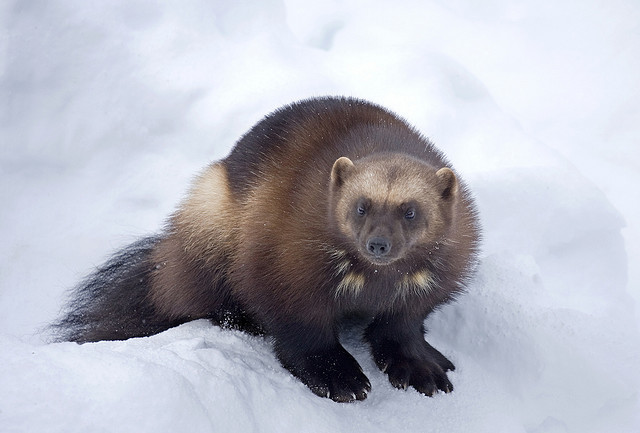
Image credits: Pekka Isomursu (above), and Michael B. (below)
For the first time ever, biologists have confirmed the presence of an adult wolverine in the Gros Ventre Mountain Range, which lies at the eastern edge of Jackson Hole, directly across the valley from the Tetons. A nighttime photograph from May of 2015 verified the presence of the mustelid—which is notorious for being hard to trace or track— in the Tosi Creek area of the Gros Ventre. The photograph is a product of research conducted by the Wolverine Initiative, but the study has since changed hands and will continue directly under Wyoming’s Game and Fish Department. To call this sighting exciting would be an understatement, for although historical accounts suggest that wolverines once inhabited the Greater Yellow Ecosystem, the animal’s current presence in the range was, until now, widely unknown. In the 19th century the species came close to extinction in the continental United States as a result of hunting, deforestation, and other human impacts. While a small number of wolverines were thought to reside across the Northern Rockies and the North Cascades, much remained unknown about the species. This sighting in the Gros Ventre helps fill in some gaps in our understanding of wolverine habitat and range, though it does not come close to answering all the questions we have about this elusive mustelid.
It is no wonder that this astonishing species has captured the curiosity of biologists and is the namesake of a popular superhero character. The wolverine, or Gulo gulo, meaning gluttonous glutton, is the largest member of the weasel family. It is so named for its insatiable, mostly carnivorous appetite for small mammals and the carrion of larger mammals. In one story, a wolverine was observed chasing an adult black bear off of a kill, an impressive feat for a twenty to fifty pound relative of the common weasel. Male wolverines are extremely territorial and may travel nearly fifteen miles a day in search of food. In fact, in 2009, an adult male wolverine captured in Grand Teton National Park, collared, and nicknamed “Jed” after the Jedidiah Smith Wilderness, surprised scientists by traveling 550 miles in two months, becoming, during his travels, the first known wolverine in Colorado since 1919.

Living at elevations between 7,000 and 10,500 feet, the wolverine is uncannily skilled for life in high, snowy mountains like those in Wyoming. In fact, snowpack is integral to wolverine propagation and survival. A wolverine can detect a carcass twenty feet below the snow surface. Females dig deep snow dens for their kits to be born and nursed in, using the snowpack to protect the kits both from harsh cold as well as from predators. In addition, wolverines’ disproportionally large paws and long, curved claws function as natural snowshoes and crampons. From all of these adaptations, it’s clear that, without habitat loss and overhunting, the wolverine would be a natural fit for the climate and terrain of Wyoming’s mountains. It’s that excellent fit that makes this recent wolverine recording all the more exciting: it seems that, at long last, the wolverines have come home to the Gros Ventre Mountains.
But the excitement of this recent Gros Ventre wolverine should be tempered by the reality of today’s mountain environments. Wolverines will be an indicator species of the effects of climate change and other human activity, such as backcountry recreation, for decades to come. Still, despite these considerations, the recent discovery of a wolverine in the Gros Ventre Range lends hope that the mighty mustelid is back. Let’s hope it’s here to stay.
Information in this blog from: Koshmrl, Mike. Biologists find wolverines in their suveys. Jackson Hole News and Guide, http://www.roundriver.info/blog/biologists-find-wolverines-in-their-surveys


